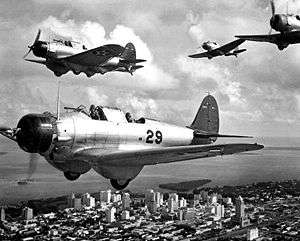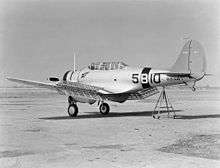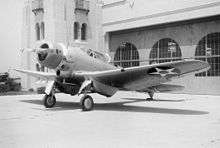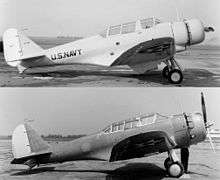Northrop BT
The Northrop BT was an American two-seat, single-engine monoplane dive bomber built by the Northrop Corporation for the United States Navy. At the time, Northrop was a subsidiary of the Douglas Aircraft Company.
| BT | |
|---|---|
 | |
| Northrop BT-1s over Miami in October 1939 | |
| Role | Dive bomber |
| National origin | United States |
| Manufacturer | Northrop Corporation |
| First flight | 19 August 1935 |
| Primary user | United States Navy |
| Number built | 55 |
| Developed into | Douglas SBD Dauntless |
Design and development
The design of the initial version began in 1935. It was powered by a 700 hp (520 kW; 710 PS) Pratt and Whitney XR-1535-66 double row air-cooled radial engine and had hydraulically actuated perforated split flaps (dive brakes), and main landing gear that retracted backwards into fairing "trousers" beneath the wings.[1] The perforated flaps were invented to eliminate tail buffeting during diving maneuvers.[1]
The next iteration of the BT, the XBT-1, was equipped with a 750 hp (560 kW; 760 PS) R-1535. This aircraft was followed in 1936 by the BT-1, powered by an 825 hp (615 kW; 836 PS) R-1535-94 engine. One BT-1 was modified with a fixed tricycle landing gear and was the first such aircraft to land on an aircraft carrier.

The final variant, the XBT-2, was a BT-1 modified to incorporate landing gear which folded laterally into recessed wheel wells, leading edge slots, a redesigned canopy, and was powered by an 800 hp (600 kW; 810 PS) Wright XR-1820-32 radial.[1] The XBT-2 first flew on 25 April 1938, and after successful testing the Navy placed an order for 144 aircraft. In 1939 the aircraft designation was changed to the Douglas SBD-1 with the last 87 on order completed as SBD-2s. By this point, Northrop had become the El Segundo division of Douglas aircraft, hence the change.
Operational history


The U.S. Navy placed an order for 54 BT-1s in 1936 with the aircraft entering service during 1938. BT-1s served on USS Yorktown and Enterprise. The type was not a success in service due to poor handling characteristics, especially at low speeds, "a fatal flaw in a carrier based aircraft."[2] It was also prone to unexpected rolls and a number of aircraft were lost in crashes.
Variants
- XBT-1
- Prototype, one built.
- BT-1
- Production variant, 54 built.
- BT-1S
- A BT-1 (c/n346, BuNo 0643) was fitted with a fixed tri-cycle undercarriage. This aircraft was damaged in a crash on 6 February 1939, returned to Douglas and repaired to BT-1 standard.[1]

- XBT-2
- One BT-1 modified with fully retractable landing gear and other modifications.
- BT-2
- Production variant of the XBT-2, 144 on order completed as SBD-1 and SBD-2.
- Douglas DB-19
- One BT-1 (c/n346, BuNo 0643), the former BT-1S, was modified as the DB-19 which was tested by the Imperial Japanese Navy as the Douglas DXD1 (long designation - Douglas Navy Experimental Type D Attack Aircraft)[1]
Specifications (BT-1)

Data from United States Navy Aircraft since 1911
General characteristics
- Crew: two (pilot and gunner)
- Length: 31 ft 8 in (9.65 m)
- Wingspan: 41 ft 6 in (12.65 m)
- Height: 9 ft 11 in (3.02 m)
- Wing area: 319 sq ft (29.6 m2)
- Empty weight: 4,606 lb (2,094 kg)
- Max takeoff weight: 7,197 lb (3,271 kg)
- Powerplant: 1 × Pratt & Whitney R-1535-94 Twin Wasp Jr. double row radial air-cooled engine, 825 hp (615 kW)
Performance
- Maximum speed: 193 kn (222 mph, 357 km/h) at 9,500 ft (2,900 m)
- Cruise speed: 167 kn (192 mph, 309 km/h)
- Range: 1,000 nmi (1,150 mi, 1,852 km)
- Service ceiling: 25,300 ft (7,710 m)
- Rate of climb: 1,270 ft/min (6.5 m/s)
Armament
- Guns:
- 1 × .50 in (12.7 mm) machine gun
- 1 × .30 in (7.62 mm) machine gun
- Bombs: 1,000 lb (454 kg) bomb under fuselage
Notable mentions in media
Northrop BT-1s appeared in pre-war yellow wing paint schemes in the Technicolor film Dive Bomber (1941) starring Errol Flynn.
See also
Related development
Aircraft of comparable role, configuration and era
Related lists
References
- Notes
- Rene J. Francillon (1990 ed), McDonnell Douglas Since 1920, Volume I. Annapolis, Maryland, Naval Institute Press
- "Northrop BT-1." historyofwar.org. Retrieved: 5 December 2009.
- Bibliography
- Bowers, Peter M. United States Navy Aircraft since 1911. Annapolis, MD: Naval Institute Press, 1990, ISBN 0-87021-792-5.
- Brazelton, David. The Douglas SBD Dauntless, Aircraft in Profile 196. Leatherhead, Surrey, UK: Profile Publications Ltd., 1967. No ISBN.
- Drendel, Lou. U.S. Navy Carrier Bombers of World War II. Carrollton, TX: Squadron/Signal Publications, Inc., 1987. ISBN 0-89747-195-4.
- Gunston, Bill. The Illustrated History of McDonnell Douglas Aircraft: From Cloudster to Boeing. London: Osprey Publishing, 1999. ISBN 1-85532-924-7.
- Kinzey, Bert. SBD Dauntless in Detail & Scale, D&S Vol.48. Carrollton, TX: Squadron/Signal Publications, Inc., 1996. ISBN 1-888974-01-X.
- Listemann, Phil. Northrop BT-1 (Allied Wings No.3). France: www.raf-in-combat.com, 2008. ISBN 2-9526381-7-9.
- Swanborough, Gordon and Peter M. Bowers. United States Navy Aircraft since 1911. London: Putnam, Second edition, 1976. ISBN 0-370-10054-9.
External links
| Wikimedia Commons has media related to Northrop BT. |